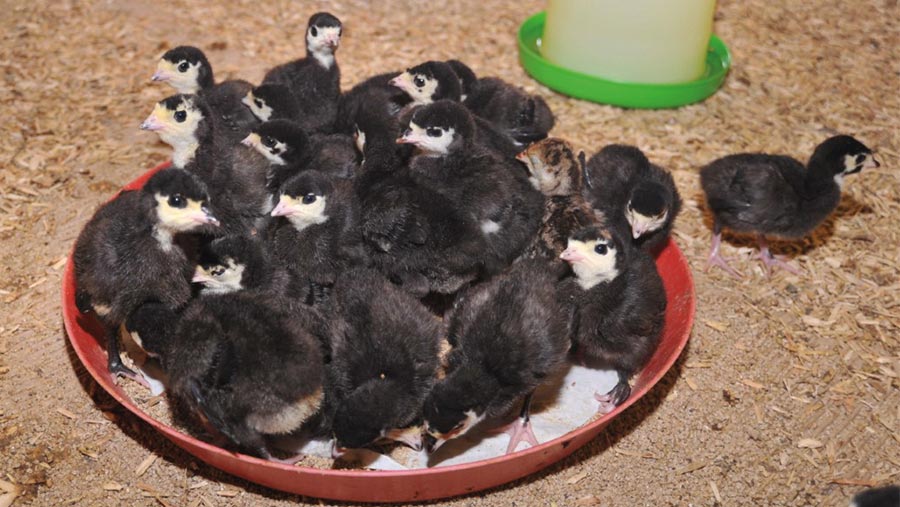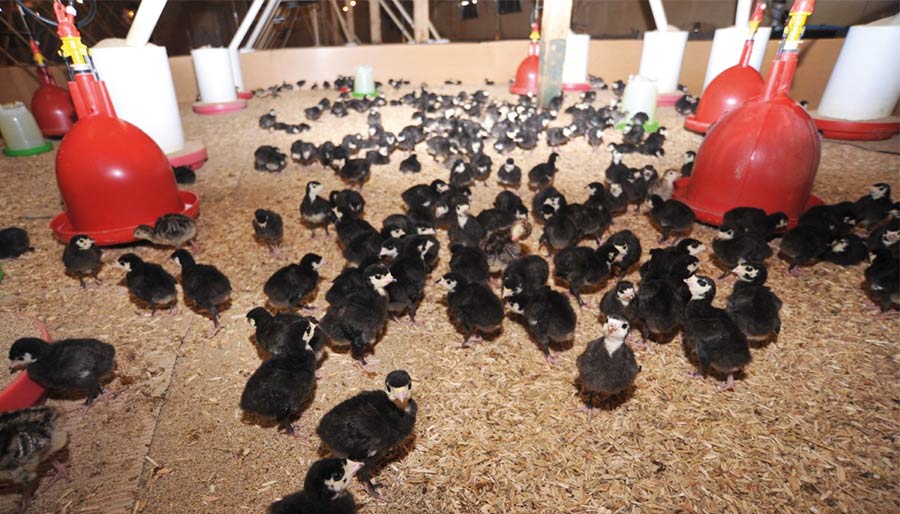Advice on getting gut health right in young seasonal birds
 © Debbie James
© Debbie James Gut health and growth performance in seasonal birds can be a challenge from the outset, so careful management of the young flock is key to ensure it achieves its potential.
A bird’s digestive tract is fragile in the first few weeks of life as it undergoes fundamental development. Young seasonal birds that get a good start are therefore more likely to finish well.
Vet Sam Northing of Avivets, a Cheshire-based commercial poultry practice, explains some of the measures to ensure birds thrive from day one.
See also: What to consider before going into seasonal turkey production
Early development
Early feed intakes stimulate gut development by encouraging the growth of villi, the finger-like protrusions which line the inside walls of the intestine.
These microscopic villi aid the absorption of nutrients, so encouraging their development means the bird can digest and absorb more feed, more efficiently.
The gut microbiome – the resident bacteria in the intestinal tract – also establishes in the first week of life.
This helps to exclude ingested micro-organisms and pathogens that could be detrimental to health and performance in the long-term.
The good bacteria also help support the bird’s immune system.
However, feed intakes and gut health can be depressed by:
- Incorrect temperature
- Poor ventilation
- Feed management
- Water management
- Disease.
Feed management
Hindrances to finding food and water include obvious factors such as insufficient feeders and drinkers, but litter which is too deep or unevenly spread can also prevent small birds from moving freely.
Aim for a minimum of one feeder per 100 poults so that feed is readily available from the outset. These mustn’t be set too high or chicks will be unable to access them. Gauge the correct level by watching the birds, and adjust feeders as they grow.
The feed used must be specific for the type of bird. Turkeys in particular are susceptible to coccidiostats which may be present in other types of feed. There is a diet specific to every stage of a bird’s life, for every species.
One of the most important differences between the diets is levels of protein.
The meat bird will require lots of protein for growth. In the young bird flock, keepers should check whether the crop is full. This is the first part of the digestive tract and can be felt on the front of a bird, at the base of the neck.
It should be quite firm but not hard, Check that most birds in a sample – say 100 birds from across the house – have eaten within the first 24 hours, Mr Northing advises.
Water

© Debbie Jamers
Flushing drinker lines regularly when chicks are young keeps water cooler and more palatable, and both water and feed intakes will be maintained.
It will also prevent bacterial build-up in the lines, as water flow will be slower while poults are young and flock consumption levels are low.
Birds should not have to travel far for drinkers, so allow 100 birds per standard 18-inch bell drinker. If they are dehydrated after a long journey, electrolytes can be helpful.
These help to rehydrate the bird by providing both water and dissolved salts that are vital for cell functioning and maintenance of fluid balance in the body, such as sodium, chloride and potassium.
Some producers give these routinely on arrival.
Introducing probiotics into drinking water from arrival also encourages the correct gut microflora and is beneficial to gut health.
Ventilation/draughts
Draughts will affect feeding and bird dispersal across the housing. It is vital to address problems before the birds arrive.
“If you can feel a draught, the young turkey will too, so to avoid chills, deal with these before birds arrive,” Mr Northing says.
Temperature
A poult weakened by sub-optimal body temperature of less than 40-41C is at heightened risk of gut infection.
Failure to sustain the correct ambient temperatures will also lead to huddling, which means poults won’t be exploring their environment and finding the feeders and drinkers, warns Mr Northing.
To sustain the birds’ body heat when making the transition from the hatchery to the rearing unit, the ambient temperature should be no lower than 36-37C.
Pre-heating housing 24 hours before chicks arrive will warm both the air and the floor. The floor temperature should be at least 30C which can be measured using a laser probe.
After the first 24 hours the temperature should be decreased by about 1C each day.
Key diseases and parasites
The young bird is also susceptible to infection from a range of diseases and parasites.
Histomoniasis, or blackhead
This fatal disease is caused by a parasite which has a lifecycle that includes earthworms and the caecal worms of chickens.
Chickens are more resistant to histomoniasis than turkeys which means the parasite can build up in worm hosts in the environment without a noticeable effect, says Mr Northing.
“This can spell disaster when a flock of young turkeys arrives on the site,” he says. Worming for parasites is, therefore, extremely important in all seasonal poultry. Even birds in indoor systems can contract worms.
“Turkeys are usually wormed a couple of weeks after birds go outside – but farmers should talk to a vet about a specific worming plan,” Mr Northing advises.
Coccidiosis
Coccidiosis is caused by a tiny parasite that affects the birds’ intestines. If untreated, birds will have reduced weight gain or die.
Warning signs are loose droppings, thin and low-appetite birds, huddling in groups, sluggishness and sudden deaths.
Coccidia replicate quickly in dirty, wet bedding. Although some exposure to coccidia is important for developing immunity, this exposure must be below a certain level to avoid clinical signs.
Managing air quality to reduce humidity so that litter remains friable with not too much moisture is key.
While it is near impossible to eradicate coccidia from housing, good biosecurity and coccidia-specific disinfectants will help to limit the pathogen, Mr Northing says.
Turkey haemorrhagic enteritis virus (Thev)
This disease causes depression and bloody stools in poults from a few weeks of age. It can have a high fatality rate, so any hint of this disease must be evaluated quickly by a vet.
Preventative vaccines are available and it is important to discuss timing with your vet.
Poults receive immune protection from their mother against the virus, via antibodies in the egg yolk, but this protection is not permanent.
A vaccine is available and this must be given once the inherited immunity starts to wane. Farmers should work with their vet to come up with a tailored vaccine plan.
Duck viral enteritis
This disease of ducks and geese is associated with contact with wild fowl and poor biosecurity.
Avoid mixing groups of birds of different ages and, if they have outdoor access, try to deter wild birds to avoid contamination of water, where the virus can survive for many weeks.
Mr Northing says: “Deterring wild birds is obviously difficult but if you notice, for example, a flock of migratory geese resting on the range then it would be best to shoo these away.’’
Vigorous cleaning and disinfection are key and flock-keepers should consult their vets over a vaccination programme.
